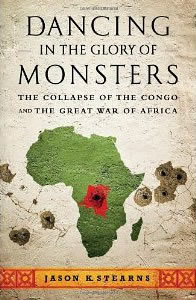Book Notes
 Jason K. Stearns, Dancing in the Glory of Monsters; The Collapse of the Congo and the Great War of Africa (New York: Public Affairs, 2011), 380pp.
Jason K. Stearns, Dancing in the Glory of Monsters; The Collapse of the Congo and the Great War of Africa (New York: Public Affairs, 2011), 380pp.
The deadliest war of our generation has been the under-reported conflict in the Democratic Republic of the Congo (former Zaire). Since the start of conflicts there in 1996, five million people have perished out of a population of fifty million — a staggering 10% of the population. Over half of those deaths occurred since the war ended in July 2003. The overwhelming majority of the victims were civilians; about half of them were children. Millions more Congolese have fled to neighboring countries as both a cause and consequence of the war. Hundreds of thousands of women have been raped. Peace accords officially ended the war, although continued hostilities and the social, economic and political consequences of the war make for a fragile peace.
How do you understand a war in a country the size of western Europe (the twelfth largest in the world), with 200 ethnic groups, and that involved nine border countries, the interventions of countries like France, Belgium, the United States, Cuba, and China, and thirty rebel militias and proxy armies composed of mercenaries from as far away as Serbia? Next to the work by Gerard Prunier, Africa's World War; Congo, The Rwandan Genocide, and the Making of a Continental Catastrophe (Oxford, 2009), Jason Stearns has written a critically-acclaimed account, based upon ten years of living and reporting from the region. His book bears witness to the untold stories of many millions of Congolese citizens.
The Congo has suffered four hundred years of "political disintegration" that began with the European and Arab slave trade of the sixteenth century, and was followed by the wholesale plunder of the region in the nineteenth century by Belgium's King Leopold (see King Leopold's Ghost by Adam Hochschild). When independence from Belgium came in 1960, "the colonial authorities handed over government to a Congolese people almost wholly unprepared to manage their vast state" (330). For thirty-two years president Joseph Mobutu Sese Seko, who was backed by the United States, epitomized corruption, repression, and incompetence (1965–1997). Laurent Kabila overthrew Mobutu in 1997, was himself assassinated in 2001, and was followed by his son Joseph Kabila.
The "trigger" for the first Congolese war was the 1994 Rwandan genocide, when mainly Hutu people slaughtered 800,000 Tutsis in the space of three months. About a million Hutus then fled two hundred miles west into eastern Congo, set up a government in exile, and were pursued by the new Tutsi government that sought retaliation. Mobutu supported the Hutus against Rwanda's Tutsi government. About 50,000 refugees perished in the first month from starvation, cholera, thugs, and massacre by the Rwandan government.
This "first" Congo war lasted until Kabila overthrew Mobutu in 1997. The "second" Congo war pitted Kabila against Uganda and Rwanda in more obvious economic conflicts from 1998 until the peace accords of 2003. But like the layers of an onion, the Congo conflict contained "wars within wars" that were the product of many causes (69). Self-defense and retaliation were obvious. Political ideologies played some part. Economic plunder of Congo's vast natural resources of copper, cobalt, and diamonds enriched unscrupulous companies and especially Uganda and Rwanda, threatening about the only way for Congo to pay for its war. The regional politics of nine neighboring states exacerbated conflicting interests. It's easy to criticize the deep ethnic hostilities, but as Stearns notes, ethnicity was the last and strongest personal and institutional identity left in the country after the near complete erosion of the state. He concludes: "The Congo war had no one cause, no clear conceptual essence that can be easily distilled in a couple of paragraphs. Like an ancient Greek epic, it is a mess of different narrative strands" (336).


